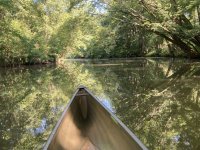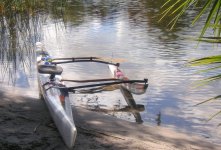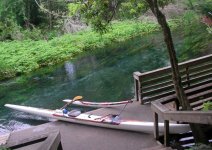No wind yesterday. Opaque water was still. Got out early to beat the heat. I decided to leave the double blade in the car, did the entire loop with my bent shaft ZRE Whitewater carbon fiber paddle. I paddled my Blacklite Phoenix. Water is still high in the reservoir and backwater areas.
I used an app to gauge both effort and progress without adverse conditions. The phoenix is fun to paddle (without a dog). It turns effortlessly. My best rate was 21 minutes per mile using the sit and switch approach. J stroking was 5 mins slower, and hurt my shoulder paddling on the left side only. I might have been faster using a straight shaft paddle while j-stroking.
The light weight of the Phoenix makes loading and carrying easy. No need for a yoke at all, although the shoulder did sore up a little, it’s the “good kind” of soreness mostly.
I tried using the double blade last time I did this stream and was able to go at a 15 min/mile clip. There was some minor wind that day, however.
I’d love to use the Phoenix on the Little Miami River, but the rocky sections can be brutal. Looking for other places to explore with this little boat.
I used an app to gauge both effort and progress without adverse conditions. The phoenix is fun to paddle (without a dog). It turns effortlessly. My best rate was 21 minutes per mile using the sit and switch approach. J stroking was 5 mins slower, and hurt my shoulder paddling on the left side only. I might have been faster using a straight shaft paddle while j-stroking.
The light weight of the Phoenix makes loading and carrying easy. No need for a yoke at all, although the shoulder did sore up a little, it’s the “good kind” of soreness mostly.
I tried using the double blade last time I did this stream and was able to go at a 15 min/mile clip. There was some minor wind that day, however.
I’d love to use the Phoenix on the Little Miami River, but the rocky sections can be brutal. Looking for other places to explore with this little boat.

Last edited:



